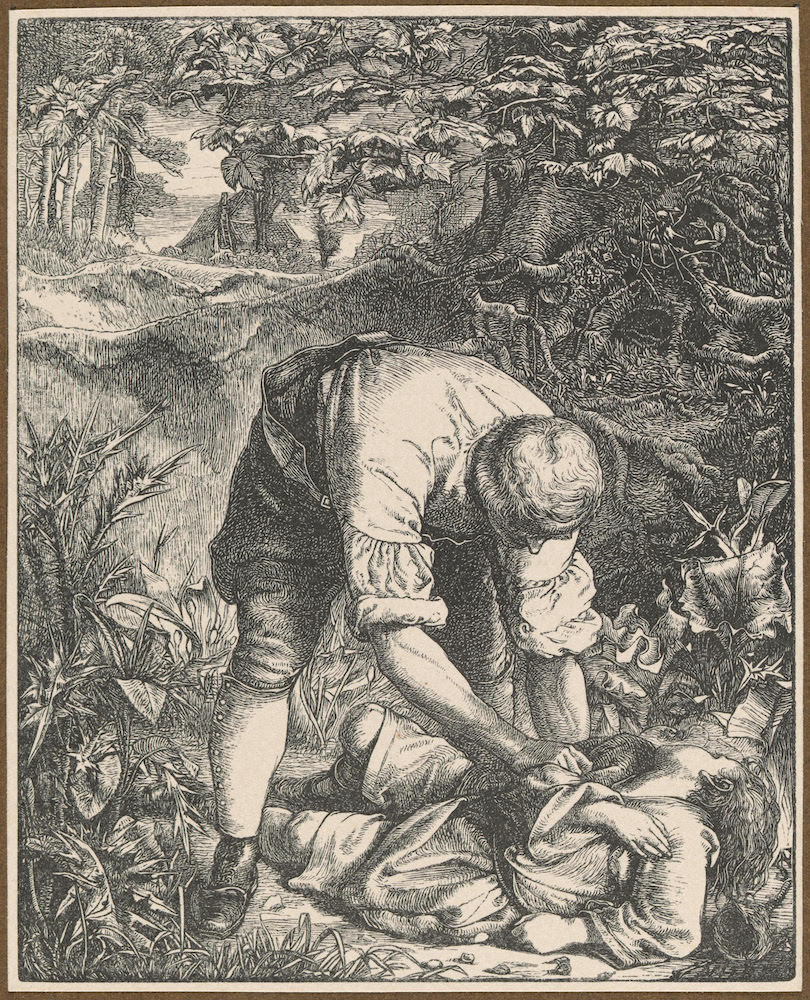

Life's Journey. Left: 1861. Brush and black ink on tan paper, 5 5/16 x 4 5/16 inches (13.7 x 11.3 cm). Collection of Birmingham Museums and Art Gallery, accession no. 1906P847. Image courtesy of Birmingham Museums Trust made available under a Creative Commons Zero licence. Right: 1862. Wood engraving on paper, engraved by the Dalziel Brothers. 5 x 4 inches (12.7 x 10.2 cm) – image size. Collection of the National Gallery of Victoria, Melbourne, accession no. 2929.45-4. Image courtesy of the National Gallery of Victoria. [Click on the images to enlarge them.]
Sandys first started designing illustrations in 1860. Forrest Reid has described the working method he used for his illustrations:
He drew everything from life, seldom even making use of the lay figure for his draperies, and in fact did nothing without a model before him. It was his method to prepare most careful studies in pen and ink or pencil, before drawing direct on the wood, block. He never used Chinese white to lighten or correct, but worked from a large slab of Indian ink. Sandys drew in pure black line, never forgetting that his drawing had to pass through the hands of the engraver, and that its ultimate appearance depended on the success with which the latter could reproduce it. He left as little to chance as possible; he did not experiment in tints; he knew the engraver's limitations and gave him no more than he could do. [56]
Sandys did not draw on the wood block in ink with a pen, but used a fine sable brush instead, as has been described by Percy Bate:
This fact is possibly due to the artist's method of working on the block after he made the pen drawing on millboard. He told me that his first box-wood block was a puzzle to him when he received it, with the request from Thackeray that he would supply an illustration to a story of George Macdonald for the Cornhill. He knew nothing of the correct method of preparing it; it was impossible to work on its smooth surface with either pencil or pen, and he finally drew The Portent line by line with a brush in Indian ink, and found the process so simple and the results so satisfactory that he always thereafter employed the same method" (7).
In describing the drawing for Life's Journey, Betty Elzea compares it to the illustration which is printed in reverse: "A man bends over a boy lying, injured, on his side on the ground. Above to the left of the figures is an over-hanging tree whose gnarled roots cover a high bank. In the upper right distance is a cottage and a grove of trees. In the lower right foreground as a tall thistle. In comparison with the printed illustration, details in the foreground, middle distance, and background are unfinished. For instance, Sandys added a bird's nest and his monogram near the boy's head. Minor foliage details and shadowy textured areas were also added to the design on the block" (204).
The drawing was commissioned to illustrate a poem "Life's Journey" by George Wither included in the Rev. Robert Aris Willmott's English Sacred Poetry, first published in 1862 by Routledge, Warne, & Routledge. This was the first design by Sandys to be engraved by the Dalziel Brothers firm. Elzea explains that the poem and illustration are an allegory "likening the poet's passage through life to the exploratory wanderings of a child (in Sandys's illustration, the child was bird's-nesting and fell from a tree) whose loving father (God) never fails to rescue him when needed" (205). Sandys was pleased with the wood engraving that resulted from the Dalziel Brothers cutting of his design on the woodblock.
Forrest Reid in his book on illustrators of the 1860s period praised this illustration: "To 1862 also belong the two lovely drawings for Willmott's English Sacred Poetry. 'Life's Journey' shows a father finding his little boy who has been lost in the woods, and nothing more living and beautiful than the figure of the lost child can be imagined" (60).
The original drawing was exhibited at the Arts and Crafts Exhibition Society held at the New Gallery in London in 1893, no. 339, and then later at the Winter Exhibition held at the Royal Academy in 1905, no. 279c, that featured works by both Sandys and G.F. Watts. In both instances the drawing was lent by Charles Fairfax Murray.
Bibliography
Bate, Percy "The Late Frederick Sandys: A Retrospective." The Studio XXXIII (October 1904): 3-17.
Elzea, Betty. Frederick Sandys 1829-1904. A Catalogue Raisonné. Woodbridge, Suffolk: The Antique Collectors' Club Ltd., 2001, cat. 2.B.21, 204-05.
Life's Journey. Birmingham Museums. Web. 21 August 2025.
Life's Journey. National Gallery of Victoria. Web. 21 August 2025.
Reid, Forrest. Illustrators of the Sixties. London: Faber & Gwyer Limited, 1928.
White, Gleeson. "A Great English Illustrator." Pall Mall Magazine XVI (November 1898): 338.
Wilmott, Robert Aris, ed. The Poets of the Nineteenth Century. London: George Routledge, 1857 (the original illustration on this page, added George P. Landow, appears on p.7).
Created 1 November 2009
Last modified 21 August 2025